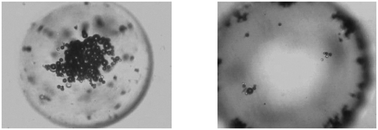Electrohydrodynamic manipulation of particles adsorbed on the surface of a drop
Abstract
In our previous studies we have shown that particles adsorbed on the surface of a drop can be concentrated at its poles or equator by applying a uniform electric field. This happens because even when the applied electric field is uniform the electric field on the surface of the drop is nonuniform, and so particles adsorbed on the surface are subjected to dielectrophoretic (DEP) forces. In this paper, we study the behavior of adsorbed particles at low electric field frequencies when the drop and ambient liquids are weakly conducting dielectric liquids, and model it using a leaky dielectric model. The electrohydrodynamic (EHD) flow which arises because of the accumulation of charge on the surface of the drop can be from pole-to-equator or equator-to-pole depending on the properties of the drop and ambient liquids. The flow however diminishes with increasing frequency and there is a critical frequency at which the drag force on a particle due to the EHD flow becomes equal to the DEP force, and above this critical frequency the DEP force dominates. When the fluid and particles properties are such that the EHD and DEP forces are in the opposite directions, particles can be collected at the poles or the equator, and also can be moved from the poles to the equator, or vice versa, by varying the frequency. Also, it is possible to separate the particles of a binary mixture when the critical frequencies of the two types of particles are different.


 Please wait while we load your content...
Please wait while we load your content...